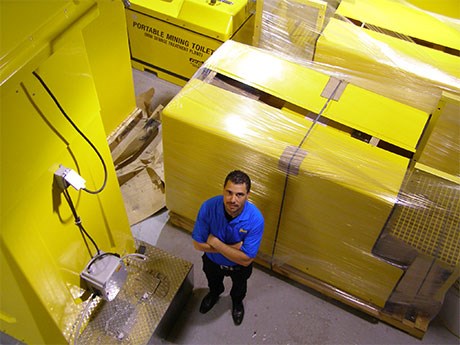Miners can look forward to new improved toilets underground in the near future, if they haven’t already had a chance to use them.
Sudbury-based Rezplast Manufacturing introduced the first major redesign of its environmentally friendly toilets in Timmins at the Canadian Mining Expo in May. The Ecolav toilet is a new, improved version of Rezplast’s Mining Toilet released in 2004.
Vice-president Sandro Spadafora has been with the company for 16 years and he’s seen the development of the company from a mining shower producer to an international leader in toilet technology. He boasts that the new toilet puts its users in the “lap of luxury,” and says Rezplast hopes to bring “porta pottys to the next level.”
The redesign was inspired by feedback on the original toilet, and the increasing number of women working underground.
Major comments were that there was an unpleasant draft coming through the hole and that it was not spacious enough to comfortably disrobe. This was especially noticed by women who have unique needs
The 2004 toilet measured three feet by 5.6 feet at the base and stood seven feet tall. It had an open base and a seat like those found in standard portable toilets.
The new design introduces a porcelain toilet, exactly like what you would expect at home. The unit is completely enclosed, creating a more private feel, measures four feet by seven feet, and stands a generous 9.5 feet tall. A sink with hot and cold running water is available as an option.
The unit is made of fiberglass, which is flame resistant, strong and easily adapted to various shapes and uses. The rest of the unit is composed of stainless steel and aluminum, to resist corrosion. Durability is a design priority for these toilets, as is low maintenance.
The 2004 version only had to be serviced every two years thanks to the innovative anaerobic enzyme developed by Rezplast and Swish Maintenance that turns the toilets into “miniature biotreatment plants.” Spadafora says it was developed to withstand the unique environments in the North; it can withstand dramatic changes in temperatures, survive multiple freeze-thaw cycles and is adapted to the dark, damp conditions in mines. “It’s not your typical enzyme,” he noted.
The enzyme eliminates odour almost completely, an important feature when the toilets are often placed in proximity to the workplace, said Spadafora.
This same enzyme is used in the Mining Toilet’s tank. However, the Ecolav features two tanks to separate fresh and waste water, which allows the inclusion of a flush feature on the toilet. The introduction of a fresh water tank also qualifies the Ecolav as a potential health and safety sanitation station, rather than a simple toilet.
While the Ecolav has to be serviced more frequently – approximately every six months – this is still far less often than is the case with the standard portable toilet.
The difference in size also means that the Ecolav needs a forklift to place the base, but the rest can be assembled by one person. The original Mining Toilet could be assembled by just two people, which makes it appealing to mines in remote areas.
The new toilet does need electricity, but all of the electrical wiring and water hookups are quick connects, making component replacement easy and economical.
Most Sudbury mines use Rezplast’s toilets, said Spadafora, but they are also in use elsewhere in Northern Ontario, as well as in South and Central America.
Spadafora says in their early days, they counted and tracked each and every toilet they sold. Today, there are so many headed out the door, he’s lost count.


